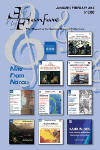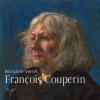Texte paru dans: / Appeared in:

Fanfare Magazine: 36:3 (01-02/2013)
Pour
s'abonner / Subscription information
Les abonnés à Fanfare Magazine ont accès aux archives du
magazine sur internet.
Subscribers to Fanfare Magazine have access to the archives of the magazine
on the net.
Aparté
AP036

3149028016628 (ID228)
Consultez toutes les évaluations recensées pour ce cd
~~~~ Reach all the evaluations located for this CD
This disc is being pushed as an event: “one of the last living legends of the harpsichord” (all other living harpsichordists not having what it takes to become legends, whatever that may be) returning to the recording studio for the first time in nine years. Don’t get me wrong: Blandine Verlet is a talented and insightful musician who has been teaching, concertizing, and recording for a very long time; her first album was issued in 1973, in Telefunken’s Das Alte Werk series. (Frescobaldi on SAWT 9597, and yes, I’ve still got my LP of it.) However, I’m inclined to think that each of an artist’s releases should be judged on its own merits; and when part of a series, viewed as a snapshot in a stylistic continuity.
Verlet has recorded a great deal of Couperin le Grand over the years, but her approach to that composer has remained consistent. If I were asked to define it in only a few words, they would be very angular phrasing, moderate to fast tempos, and coolly expressive interpretation. The angular phrasing would likely be the first element to strike a new listener to this release. It can be heard at its best in “La Monflambert” and “l’Adolescente,” flowing naturally through the logic of the music, emphasizing details without drawing attention away from either the rhetoric of the piece, or its ongoing movement. Not so in “La Misterieuse.” Verlet’s heavy employment of agogics produces a choppiness that fights the piece. Kenneth Gilbert, in his Couperin series (sadly deleted, though some copies are still to be found), takes a similarly flexible approach to phrasing, but is more gradual and rounded. This creates an effect of allowing each work to expand naturally, along the historical lines of style brisé.
Gilbert also chooses slightly more relaxed tempos than Verlet in general. Her performances have an underlying nervousness of pulse that works very well for some pieces, less well in others. Returning to “La Misterieuse,” whether you believe that Couperin wrote this particular work to fit a predetermined image or came up with the title after finishing the piece, Verlet’s performance can not be said to invoke an enigmatic woman.
Much the same can be written of Verlet’s “Les Pavots.” Couperin offers us a musical image associated with the lassitude produced by an infusion of sleep-inducing poppies: an effect confirmed by several authorities, including both Madame de Sévigné and the Wicked Witch of the West. But Verlet’s poppies are an oddly jittery bunch, the pace too quick, the pulse of the music lacking in the evenness that Couperin provides to indicate slumber. Admittedly, it’s not the kind of work that acts as a good showcase for Verlet’s particular gifts, but that’s the point. She doesn’t adapt to it. Verlet offers a combination of insight, vitality, and individuality that challenges, and when she succeeds, as in “L’Unique” and “La Basque,” she often does so in a way that makes the music sound richer than some of the more forthright interpretations it has received over the years. But at other times, the effect is that of forcing a square peg into a round hole.
The instrument used on this disc is a Henri Hemsch made in Paris in 1751. It supplies a combination, perfect for Couperin’s music, of sweetness in the treble and richness in the bass. The miking is very close, however, and while there is no distracting mechanical sound, this album is best heard at a low volume. The liner notes consist of remarks about the harpsichord, and a poem written by Verlet to Couperin, commiserating at length with the composer over the early loss of his mother. And no, I’m not exaggerating. That’s it.
My recommendations? Michael Borgstede (Brilliant Classics 93082) is more straightforward, if a bit fast overall and inclined to slight tendresse. Olivier Baumont (Warner Classics 4641762), a Gilbert student, is subtler in his phrasing, and performs the ornamentation with especial expressiveness. But Verlet at her best is more interesting than either, just as at her worst she gives an impression of believing her own ideas superior to Couperin’s. Sample Verlet on the Web, and decide before you buy.
Cliquez l'un ou l'autre
bouton pour découvrir bien d'autres critiques de CD
Click either button for many other reviews


